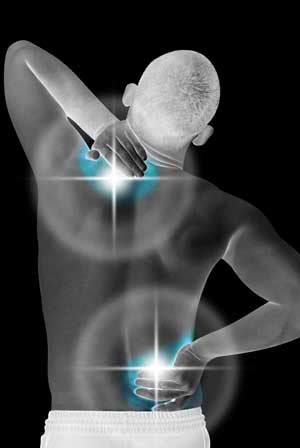In 2001 Donna Jackson Nakazawa – a journalist and mother – was paralyzed in a sudden onset of Guillain-Barré Syndrome, an autoimmune disease similar to multiple sclerosis. She slowly regained her ability to walk and drive only to be paralyzed by another more serious attack in 2005. Along the way, she was also diagnosed with thyroiditis, nerve damage, a clotting disorder, bowel problems, slipped discs, and strange fevers. Within a few years, she’d gone from being able to swim 60 laps to being perpetually worried, exhausted, and in pain.
Having exhausted the usual medical options, and cognizant of studies showing the power of mind-body medicine to affect health, Donna engaged with Integrative Medicine specialist Dr. Anastasia Rowland-Seymour at Johns Hopkins to bring joy back into her life and hopefully improve her health. We’ve been following Donna’s progress in a blog series.
When you see and feel the sensations you are experiencing as sensations, pure and simple, you may see that these thoughts about the sensations are useless to you at that moment and they can actually make things worse than they need to be. John Kabat Zinn
Donna’s been doing her mindfulness “on the fly”, applying it as she goes about her day. Now she devotes half an hour to an hour a day to meditation – she’s becoming a meditator. The goal, as always, is to quiet the mind.
As they settle into the Mindfulness-Based Stress Reduction (MBSR) class, Trish Magyari asks them to ask themselves, “How am I doing right now”?
At that question, every reason for not doing mindfulness – for escaping into some kind of distraction – blares into Donna’s mind. Her stomach pains, numb feet, headache, brain fog, back spasms, and the flu-like fatigue that’s always present immediately come to the fore. This is why, she says, she never asks herself how she is doing now. The response to that question is overwhelming – and depressing.
Hanging out with what is going on right now is what Buddhism is all about, though. Instead of racing from painful sensations, negative emotions, and thoughts, you welcome them in. They’re part of your experience. The only way to get through them is to be with them – to actually, in a sense, welcome them. Trish recommends meeting discomfort and pain with a little kindness. This is not a Western way of doing things.
Interlude
In her book “Radical Acceptance” Tara Brach, who experienced a four-year bout with a chronic fatigue syndrome-like illness provides a guided meditation on the “Radical Acceptance of Pain”.
It involves a relaxation period, a gentle scanning of the body, and then bringing “a receptive attention” directly to unpleasant sensations being experienced. She asks if the body and the mind are “clenched like a fist” in their efforts to resist the pain and asks the participant to soften their resistance to it and allow the unpleasant sensations to be just as they are. She suggests that one experience their awareness as a “soft space” that surrounds the pain.
As soon as this has been established, she has the participant more precisely describe the pain. Is it burning pain? A stabbing, aching, twisting, or throbbing pain? Does it feel like a knot or like a great weight has been pressed on it? (Some meditators ask if it has a certain color or shape.)
This is using the analytical part of the brain to redefine the pain sensation. Instead of being a horrible thing, it’s a throbbing thing or a weighty thing.
When resistance occurs she suggests the participant relax and let their body become like an open space. She asserts that doing this over time will allow your equanimity to increase.
Breathing
Donna finds that by giving the worrying and fearful mind some rein, those judgments can get really loud. To counter that, she takes a three-part breath – first she fills her belly, then her stomach, then her chest with air and holds it, and then rapidly exhales as deeply and quickly as possible with a big haaaaaaaaa. Donna feels lighter – something has indeed been released.
As Donna moves in a little closer, she is surprised to encounter not the usual feelings of frustration, anxiety, and overwhelm she expected, but a looming sense of sadness.
Then they’re asked to focus on the in and out of 10 breaths in a row. Research suggests that focusing on the breath for 12 seconds allows one to reach a state of concentration, and doing that over and over again creates a “concentration groove” in one’s brain – a place of calmness one can return to over and over again amidst the storm.
Donna’s able to make it to three breaths – not bad for someone who was sure she had a “meditation disability”. Trish suggests counting the breaths to help and letting out a silent ahhh on the out-breath. As her legs give her numb and prickly sensations, she meets them with the words “This, too, is okay”.
At the end, she is surprised to learn that her disturbing body sensations become okay. The fatigue, the unresponsive dead legs, the pain – it’s all okay. She’s transformed them from sensations she didn’t want to face to sensations it’s okay to have. They’re just sensations. Rocks are hard, water is wet, and she is experiencing these body sensations.
Responding to the unpleasant elements of life with “This, too is okay” highlights a core teaching of Buddhism and other spiritual and transformational approaches. The goal is to be okay with things just as they are. Resisting them causes suffering and keeps them persisting (“Whatever you resist, persists”).
Tara Brach’s audacious practice of saying “Yes” to everything in life is another form of this. Landmark Education’s practice of “choosing” everything in your life is another. The Christian practice of giving everything to God is another. All derive from the notion that suffering at its core derives from a struggle to have things be other than they are.
At home, Donna practices Andrew Weil’s breath-holding technique. She places her tongue against her upper row of teeth, breathes in through her nose to the count of four, holds her breath to the count of seven, then exhales through her mouth to the count of eight, making a loud whooshing sound. She does this four times, and then she meditates.
She feels a sweet sense of new openness that widens and widens. This time she doesn’t want to leave the moment…
- Find more in The Last Best Cure blog series here









This sounds like the breathing techniques to reverse hyperventilation from anxiety. Breathing in very deeply, holding the breath, and releasing the air through a small mouth opening like a whistle, restores carbon dioxide which relaxes the entire body and creates a feeling of well-being. The ancients knew what worked, even if they didn’t yet know the physiology behind it on a molecular level.
Dr. Natelson has found hyperventilation that is not caused by anxiety is present in ME/CFS. There appears to be a physiological cause for it. That cause is unclear, however. Whatever the reason any relief is much appreciated.
Thanks for passing the info on.
Cort,
Thank you for introducing us to Donna Jackson Nakazawa and her wonderful book. I got it and read it a few months ago based on one of your earlier blogs about it. Though my version of the “Last Best Cure” is much more haphazard and disorganized, I continue to think she’s really onto something. Paired with your blogs, the suggestions she makes and the research she shares are helping me feel that the puzzle pieces can connect. Thank you for alerting us to her book; her insights, wisdom, and humanity are a huge comfort. And thank you for being there with so much help all of the time!!!
Thanks Nancy…I peeked ahead in the book some time ago and found that the program worked out quite well!
Tara Brach’s materials have helped me much over the years; they are in CD format too (Amazon), an easy listen while waiting at the medical offices. Ancient mindfulness practices from Contemplative Outreach (Centering Prayer) incorporates both community interaction practice plus individual meditation. It’s as Christian, Buddhist, nondenominational as one likes.
For those with excitotoxic, racing brains, mantra meditation using traditional yoga mantras or personalized silent affirmations often work better and do not frustrate. Adding slow movement with breathing leans into Tai Chi or Qi Gong and works for others who tend toward agitation. Ironically, these practices are helping me undo the damage experienced
from participating in large group awareness trainings (LGATS) whose cultic, controlling nature (1980s) precipitated the ME/CFS final crash. Any group that uses the above methods in an atmosphere of hierarchic secrecy and cult techniques (research the various cult forums online) is to be avoided so more health damage does not occur. Never give any power away to these groups/religions or their charismatic leaders; people’s safe, full-on true guidance is really inside. If meditation plus a trauma history brings up too much discomfort, a carefully vetted, licensed therapist trained in these techniques may be needed, because with the losses of misdiagnosed ME/CFS unconscious content can overwhelm with unexpected ferocity.
All approaches intend to bring a person into living in the present more fully while not denying current reality and relinquish control patterns that have become counterproductive. Resistance is futile; leaning into acceptance and the flow state takes whatever time it takes to learn. The self-compassion aspect of Buddhism has been the most valuable for me. It actually makes a person a better health warrior-activist. More focus equals getting more done effectively.
I ‘m not well enough to write (this is my first post) but I wanted to leave a link to another approach that people might appreciate. It’s called Focusing and it has to do with the Felt Sense of the body and how things can shift from there. This approach is different from meditation. People who meditate may find it useful as well as others who take issue with certain aspects of meditation. Whether you like or dislike meditation, this may give you something different that you may be looking for. It’s helped me a lot and I’ve been wanting to share this information.
http://www.focusing.org/sixsteps.html
Also, thank you so much Cort for all that you do for us! The information that I’ve learned from you and from the posts on the websites that you’ve created is saving my life. Gaba agonists and methylation are what I’m working on now and it’s among the most helpful things that I’ve done; more missing pieces in tiny, tiny doses. I’m getting huge shifts in my ability to breathe; it’s like there is a pump breathing me instead of feeling like I’m breathing on manual. My heart feels much more stable and stronger and the pressure in my head has greatly changed for the better. I’m someone who has a problem with almost daily migraines and I’m much less susceptible now. My sleep has also significantly improved. Speaking of breathing and head pressure, that reminds me that yawning is also helpful. I let my mouth hang open as wide as I can until I yawn. I’ve got a friend of mine doing it now and it helps him too. We’re like Apolo Ohno! I happened to come across this online recently.
http://planetthrive.com/2010/11/yawn/
Daily laughing – he, he, he, he, he until a real laugh comes out has been my resolution this year. Don’t laugh at me, I mean go ahead and laugh at me; it helps! Laugh with someone if you can!
Thanks to everyone for their help and posts! We all need all the help and support that we can get! I’ve been sick since I had Mono and a severe strep throat in 1983. By 1995, I became mostly house confined and for almost the last decade I’ve been bedridden. I’m very isolated and it helps a lot to come to this site as often as I’m able.
Thanks Laurie….
I hope you continue to improve and improve.
Thirty plus years is a long time to deal with this but it is what it is 🙂
Yours truly,
Cort
I stil wonder what causes breathing problems in ME-patiënts. There is an oxygen problem, i think.
Gijs,
Yes, I also think that oxygen is a basic problem. No cellular machinery can work well without it. Although there have been studies with blood flow in the brain itself, there is no information, no study, no individual who has had a work up for blood flow in the vetebral and carotid arteries in the neck.
I was told by a Gigong Grandmaster Zhou ( worth reading about him) that the most important thing I could do for future health was to ” try to breathe.” ( through an interpreter, as Master Zhou doesn’t speak English) I think he is talking about what is discussed in this article.
For those who are interested in taking up meditation, Jon Kabat-Zinn has some free guided meditations on youtube. These are mindfulness meditations and it is not necessary to be Buddhist, as they are secular. If you like what you hear, you can order his book, Full Catastrophe Living, revised a couple of years ago, and the companion CDs, Guided Mindfulness Meditation Series 1. This is a program that has a lot of research behind it. It is not necessary to take a class to learn how to effectively meditate. This form of meditation is beneficial to your health and relieves depressed and anxious moods.
Some of you may also be interested in a different mode. There is a free Coursera course (coursera.org) on happiness, A Life of Happiness and Fulfillment, which you can begin at any time. You will learn research-based methods of becoming a happier person, both through the lectures and doing simple exercises to increase your happiness. You will learn things like how self-compassion and gratefulness can up your happiness levels.
Cort, is there a spot in the forums where people could form a group and do something like a series of guided meditations together (or in the same time frame) or the courser course? I’ve been meditating for a few years and often wish I had a community; going to a meditation center is difficult and exacerbates my symptoms as any social activity does (and then also takes a spot on my limited “dance card” for the week or month), but something on-line may be more healthful.
AIDS and MS were precisely treated and finally cured that very shame way. Definitively intelligence and new age pseudo medicine do not match together.
I have found that all my symptoms that you all are describing to be caused by Radiation from Microwave, Radio Frequency (RF), and Electro-Magnetic Fields (EMF) from wireless and electric equipment.
This includes cellular and DECT (your regular landline base with wireless handset) phones, Wi-Fi, “smart”meters, Bluetooth, wired mouse, juicer, electric stove, regular phone, etc.; anything wireless and electric, basically, with Wi-Fi being the worst.
A two week cruise to the Bahamas, being away from all electricity except the small amount on the boat, revealed the source of my disease.
What I have been doing to heal and stay healthy includes many approaches (diet, supplements, physical activity, etc.).
Besides Avoidance of Radiation, one habit that for me is crucial to avoid getting all these “illnesses” is to be Grounded as much as possible, especially during exposure to Radiation. Being exposed to Radiation increases the Body Voltage. Healthy-Grounding brings the Body Voltage back to normal aiding in the healing from the damage done by the Radiation, for one. Many things that are good for your health get you Grounded.
You might try turning off your wireless and get healthy-grounded sometime for awhile.